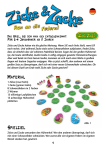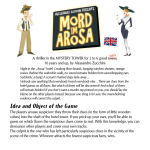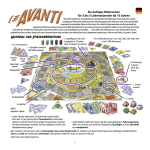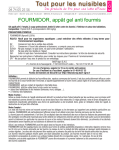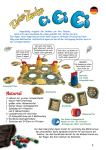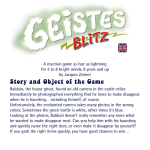Download Zoch Zicke Zacke Hühnerkacke
Transcript
Ein rasantes Gedächtnisrennen für 2–4 Junghühner ab 4 Jahren von Klaus Zoch SPIELIDEE: Im Hühnerhof ist der Teufel los!! Bei der Hühnerolympiade steht heute nämlich die Disziplin Federklau auf dem Programm. Dabei versuchen die mit spielenden Hühner sich gegenseitig zu überholen. Gelingt es einem Huhn seinen Vordermann zu überspringen, stibitzt es ihm die kostbaren Schwanzfedern. Wer zuerst alle Mitbewerber gerupft hat und alle Federn besitzt, ist Sieger. Nur wer sich auf dem Hühnerhof auskennt, kommt gut voran. Denn ein blindes Huhn mit Gedächtnislücken wird bei der Medallienvergabe mit nacktem Bürzel ganz schön gestutzt dastehen. INHALT: 24 eiförmige Wegplättchen 12 achteckige Hühnerhofplättchen 4 Hühner: 2 Hennen und 2 Hähne 4 Schwanzfedern 1 Spielanleitung SPIELVORBEREITUNG: Die 12 achteckigen Hühnerhofplättchen werden verdeckt auf dem Tisch ausgelegt und gemischt. Danach werden die 24 eierförmigen Wege plättchen offen und kreisförmig um die Hühnerhofplättchen herum ausgelegt. Hühnerhof mit Hühnerhofplättchen Eiförmige Wegeplättchen Jeder Spieler erhält nun ein Huhn, in das zu Beginn eine Schwanz feder gesteckt wird. Die Hühner werden so auf den Wegeplättchen verteilt, dass zwischen allen Hühnern der gleiche Abstand besteht. (Bei vier Hühnern sind also jeweils 5 Wegeplättchen dazwischen.) DAS SPIEL: Fortbewegung: Die Hühner bewegen sich auf den eierförmigen Wegeplättchen im Uhr zeigersinn. Das jüngste Huhn beginnt. Es darf in den Hühnerhof greifen und ein dort liegendes Plättchen umdrehen. Das Junghuhn schaut sich das Bild an und zeigt es allen Mitspielern. Das Hühnerhofplättchen wird dann wieder verdeckt an seinen ursprünglichen Platz im Hühnerhof zurück gelegt. Zuvor hat das Junghuhn natürlich das Motiv des Hühnerhofplättchens mit dem direkt vor ihm liegenden Wegeplättchen verglichen. Sind beide Motive gleich, darf das am Zug befindliche Huhn auf dieses wegeplätt chen weiterziehen. Das Junghuhn ist solange an der Reihe, bis es ein falsches Hühnerhofplättchen umdreht. 2 Stimmen die Motive Beispiel: nicht überein ist der Zug beendet. Jetzt ist das linke Nachbarhuhn ebenfalls so lange an der Reihe, bis es ein falsches Plättchen umdreht. So hüpfen die Hühner immer im Uhrzeigersinn von Plättchen zu Plättchen. ÜBERHOLEN: Beispiel: Sobald ein Huhn ein anderes Huhn eingeholt hat, darf es zum über holen ansetzen. Steht ein Huhn also direkt hinter einem anderen, darf es dieses überspringen. Dazu muss im Hühnerhof das Motiv entdeckt werden, das dem Wegplättchen vor dem zu überholenden Huhn entspricht. Gelingt dies, ist der Überholversuch erfolgreich. Dem übersprungenen Huhn dürfen alle Federn ausgerupft und dem eigenen Huhn eingesteckt werden. Beispiel: Findet das Huhn nach dem Überholen nun auch das nächste vor ihm liegende Plättchen im Hühnerhof (im Beispiel das Spiegelei) darf es sofort weiterlaufen. Ein Huhn darf auf einen Streich zwei oder gar drei Hühner überholen, wenn diese sich unmittelbar hintereinander befinden. SPIELENDE UND SIEGER: Hat ein Huhn alle im Spiel befindlichen Schwanzfedern in seinem Bürzel, hat es gewonnen. Beispiel: Das Huhn im Beispiel bekommt sogar 3 Federn, wenn es die Schnecke findet. 3 An exciting memory game for 2–4 chickens aged 4 and up OVERVIEW: A game by Klaus Zoch Today there is chaos in the chicken yard! Today‘s practice for the chicken cha cha olympics is feather stealing. Each chicken cha chas to catch each of his opponents before being caught himself. Their reward for catching another chicken is tail fea thers from that chicken. The first chicken to have all tail feathers is the winner! But only a chicken who knows what is in the chicken yard will be able to catch the other chickens and win the game. A blind chicken with a leaky memory will find themselves standing bare-rumped and medalless when the prizes are distributed. CONTENT: 24 12 4 4 1 egg-shaped tiles octagonal chicken yard tiles chickens: 2 hens and 2 roosters tail feathers rule booklet octagonal chicken yard tiles Each player chooses a chicken, puts a tail fea egg-shaped ther in one of the holes in tiles the chicken‘s rump, and places it on any one of the egg shaped tiles. The players should place their chickens so they are as evenly spaced as possible. Thus, with 4 chickens, there are 5 empty tiles between each chicken. PLAYING THE GAME: Moving: Players move their chickens in a clockwise direction around the circular dance floor. The youngest chicken starts. On a player‘s turn, he first looks at the egg-shaped tile in front of his chicken. Then he turns over one of the chicken yard tiles and shows it to all the players. If the picture on the chicken yard tile chosen is the same as the picture on the next egg-shaped tile, he cha chas his chicken forward onto that space. He then places the chicken yard tile face down back where it was. The player continues cha chaing his chicken, as long as he con tinues to choose the right chicken yard tile to match the next space on the dance floor. If he makes a mistake, his chicken stays on the tile it has reached and the player‘s turn ends. The player‘s left neighbor now takes his turn in the same way. In this way, the chickens cha cha from tile to tile, clockwise around the dance floor. On the right, the yellow player Example: finds the nest, feather, and snail, and moves successfully three spaces forward. Then yellow looks for the fried egg and cannot find it, ending her turn. The player‘s turn does not end and he continues to try to cha cha forward around the dance floor by finding a chicken yard tile that matches the egg-shaped space in front of his chicken on the dance floor. If a player fails his attempt to pass, his turn ends as normal with no penalty. Overtaking another chicken: Example: If a player‘s chicken catches up with another‘s chicken, the player may attempt to pass the other‘s chicken. To do so, the player must find the chicken yard tile matching the egg-shaped tile in front of the opponent‘s chicken. If he succeeds, his chicken jumps in front of the other chicken and steals all that chicken’s tail feathers. The player‘s turn does not end and he continues to try to cha cha forward around the dance floor by finding a chicken yard tile that matches the eggshaped space in front of his chicken on the dance floor. If a player fails his attempt to pass, his turn ends as normal with no penalty. Example: A chicken may pass more than one other chicken in a jump if they are all standing in an unbroken line as shown in the example, where the chicken in back can pass both other chickens, if the player can find the snail. GAME END AND WINNER: The first chicken to collect all the tail-feathers is the winner! example: the blue chicken can move three spaces if his player finds the snail in the chicken yard. 5 Una gara di memoria mozzafiato per 2 - 4 polli, da 4 a 99 anni. Un gioco di Klaus Zoch IDEA DEL GIOCO E OBIETTIVO: Nel pollaio si svolgono le olimpiadi dei polli ed è scoppiato il FInimondo! Oggi è in pro gramma la gara “spenna il pollo”. Questa disciplina prevede che i polli in gara orrano intorno al pollaio cercando si superarsi a vicenda. Chi riesce a superare l’avversario, può rubargli le penne della coda. Chi riesce a spennare tutti gli altri concorrenti, vince. Solo chi ricorda bene tutti i posti del pollaio potrà vincere. Un pollo distratto o con poca memoria rimarrà spennato e col sedere nudo. CONTENUTO: octagonal chicken yard tiles 24Tessere ovali (due serie uguali tra loro) 12 Tessere ottagonali (una serie uguale alle altre) 4 Polli (due galli e due galline) 4 Penne PREPARAZIONE: egg-shaped tiles Piazzate le dodici tessere ottagonali, coperte, al centro del tavolo. Disponete a caso le ventiquattro tessere ovali a formare un cerchio attorno alle altre (vedi sotto), è meglio evitare che due tessere uguali siano troppo vicine. Ogni giocatore sceglie un pollo ed una penna che inserisce in uno dei possibili buchi della coda del pollo. Piazzate i polli sul per corso in modo che si trovino alla stessa distanza l’uno dall’altro (se si gioca in quattro tra due polli ci saranno cinque tessere vuote). SVOLGIMENTO DEL GIOCO: I polli si muovono in senso orario sul percorso formato dalle tessere ovali. Inizia la partita il pollo più giovane. Il giocatore sceglie una delle tessere ottagonali e la capovolge in modo che tutti possano vederla. Egli confronta l’immagine della tesse ra scelta con quella della tessera ovale che si trova davanti al proprio pollo; se le due immagini sono uguali, il pollo avanza sulla tessera ovale. Fatto questo il giocatore capovolge la tessera ottagonale in modo da mostrarne di nuovo il dorso. Se il giocatore ha scelto la tesse ra giusta può continuare: deve sempre trovare la tessera uguale a quella che il proprio pollo ha davanti. Esempio: Nel momento in cui il giocatore sceg lie una tessera sbagliata, il suo turno finisce e tocca al giocatore alla sua sinistra che giocherà finché non scopre una tessera sbagliata. In questo modo i polli saltellano in sen so orario di tessera in tessera. SORPASSO: Appena un pollo giunge alle s palle di un avversario può provare a sorpassarlo (due polli non possono mai stare sulla stessa tessera); il giocatore deve trovare la tessera corrispondente alla tessera ova le che si trova davanti al pollo da sorpassare. Se riesce, il giocatore strappa tutte le penne della coda del pollo sorpassato e le inserisce nella coda del proprio pollo. Dopo un sorpasso il giocatore continua come di consueto finché non sbaglia. Un pollo può sorpassare due o tre polli contemporaneamente se tra questi non ci sono tessere vuote. Esempio: Esempio: FINE DELLA PARTITA: Il pollo che conquista tutte le penne in gioco vince la gara e la partita. Esempio: Se la gallina di Giuliana riuscisse a trovare la lumaca, otterrebbe tre penne. 7 ©1998 Zoch GmbH D-80333 München www.zoch-verlag.com Autor: Klaus Zoch Illustration: Doris Matthäus Vertrieb Schweiz: Carletto AG Moosacherstraße 14, CH-8820 Wädenswil www.carletto.ch
This document in other languages
- Deutsch: Zoch Zicke Zacke Hühnerkacke
- italiano: Zoch Zicke Zacke Hühnerkacke








